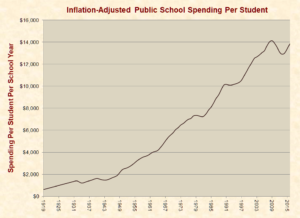Arrogantly Fleecing Taxpayers
The teachers union is coming after more of your money.
The American Federation of Teachers is on a bender, having launched a six-figure advertising campaign in which it bemoans the fact that – per its own study – 25 states “spend less on K-12 education than before the Great Recession” and that there are “massive shortfalls in education.”
AFT claims that 90 events have been scheduled, including “informational pickets, town hall meetings, forums, marches, protests and lobby days all over the country.” In an effort to show that it does not discriminate, the union scheduled a town hall in Los Angeles despite the fact that, according to their report, California is one of the states whose spending has risen since the recession. However, the union claims that the Golden State does not have enough nurses, librarians and counselors. So even though California is one of the states that is investing more in education, it, too, is being targeted.
In fact, not one state will go unscathed by AFT’s new initiative. Union president Randi Weingarten spoke before the House Committee on Education and Labor last month and rambled on about how chintzy the feds are when it comes to education spending. She insisted that teachers aren’t paid enough, and stressed the importance of finding “real, sustainable solutions to the disinvestment in public education and services.”
Now that Dorothy and Toto are safely back from Oz, it’s time to get real.
While it may be true that some states spend less than in prior times, to make this into a national cause is ridiculous. The latest figures we have from the Organization for Economic Cooperation and Development (OECD), a group of 34 countries that collects and publishes an array of data on its member countries, has the U.S. ranked #4 in spending. And what kind of bang do we get for our edu-bucks? Not very much. For example, American 15-year-olds ranked 26th out of the 34 participating countries in math on a recent international test.
In fact, over time our education spending has sky-rocketed. According to the National Center for Education Statistics and Just Facts, we can see that our outlay has increased 17-fold between 1919 and 2014.

We actually pour plenty of money into education; the problem is with allocation. I tackled this issue in a post last year. A few highlights:
- Researcher and economics professor Benjamin Scafidi found that between 1950 and 2015, the number of teachers increased about 2.5 times faster than the uptick in students. Even more outrageous is the fact that the hiring of other education employees – administrators, teacher aides, counselors, social workers, etc. – rose more than 7 times the increase in students.
- An analysis by Robert Costrell, a finance expert at the University of Arkansas, reveals that $1,301 or 6 percent of all education money goes toward teacher retirement benefits. This is more than double the amount spent on pensions in 2004 when it was $520 or 4.8 percent of per pupil expenditures.
- Whereas teacher pensions are administered by the state, healthcare benefits vary according to the local union contract. While some districts cut teachers’ health benefits off when Medicare kicks in, other districts are much more generous with taxpayer dollars. Perhaps the poster child for the latter is the Los Angeles Unified School District, which is in financial turmoil due in great part to its spiraling healthcare costs. The district provides the same generous health coverage for retirees as it does for current employees; neither group pays a premium for this give-away-the-farm health plan.
In reality, the union is doing what it is supposed to do: get as much money as possible poured into public education as it can. But as always, there is absolutely no consideration for the beleaguered taxpayer. Jon Coupal, President of the Howard Jarvis Taxpayers Association, makes the case that California’s taxpayers should consider going on strike. He points out that in the 1970s, education in the Golden State ranked near or at the top nationally. Yet today, despite spending 30 percent more on a per-student, inflation-adjusted basis than in the mid-70s, California’s latest NAEP (nation’s report card) scores are pathetic. On the 2017 test, the state was near the bottom nationally, with 69 percent of 4th grade students not proficient in both math and reading.
Taxpayers rarely complain about shelling out money for public education. But when they are abused, they need to fight back. AFT, which could also stand for “Arrogantly Fleecing Taxpayers,” is attempting to hose workers in California and throughout the country on a grand scale. Whether it be a public strike, or electing fiscally responsible legislators who are not on the union’s payroll, taxpayers need to do something to make their voices heard. Weingarten and company are only looking out for themselves. It’s time that we the people tell AFT where to stick its useless study, not to mention its spendthrift agenda.
* * *
Larry Sand, a former classroom teacher, is the president of the non-profit California Teachers Empowerment Network – a non-partisan, non-political group dedicated to providing teachers and the general public with reliable and balanced information about professional affiliations and positions on educational issues. The views presented here are strictly his own.
